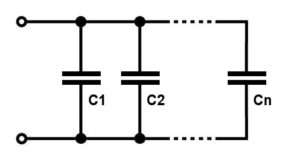This all-in-one online Parallel Capacitor Calculator finds the capacitance of a circuit consisting of any number of capacitors connected in parallel. It can also find the capacitance of the capacitor that needs to be connected in parallel with the other capacitors to get the necessary total capacitance of this circuit.
You can enter the values of any known parameters in the input fields of this calculator and find the missing parameter. To add more capacitors you can click the “+” symbol on the right hand side. You can also click the “–” symbol to delete extra lines.
Parallel Capacitance Formula
Capacitors are in parallel if they are connected to the same two points of an electrical circuit. Capacitors in parallel can be represented as the following diagram, where \(C_{1}\), \(C_{2}\), …, \(C_{n}\) are the capacitances of the capacitors connected in parallel.

An important property of a circuit consisting of capacitors connected in parallel is that they have the same voltage \(V\) across their plates. However, each capacitor in the parallel circuit may store a different charge. To find the equivalent capacitance \(C_{T}\) of the parallel circuit, note that the total charge \(Q\) stored on the plates of the capacitors is the sum of all the individual charges stored on each capacitor:
$$Q = Q_{1} + Q_{2} + … + Q_{n}.$$
Since we known that the charge on the capacitor plates is related to the voltage across the capacitor plates by the relation \(Q = CV\), the previous formula for charges can be rewritten in the following form:
$$C_{T}V = C_{1}V + C_{2}V + … + C_{n}V.$$
This equation, when simplified, gives us the expression for the total (or equivalent) capacitance of the circuit of parallel capacitors:
$$C_{T} = C_{1} + C_{2} + … + C_{n}.$$
In other words, the total capacitance of all the capacitors connected in parallel is equal to the sum of the capacitances of these capacitors.
In practice, it is sometimes necessary to find the capacitance value of the capacitor that should be connected in parallel with the existing capacitor of known capacitance to get the necessary total capacitance.
The solution to any such problem can be easily found using our Parallel Capacitor Calculator.
Related calculators
Check out our other physics calculators such as Capacitors in Series Calculator or Parallel Resistor Calculator.